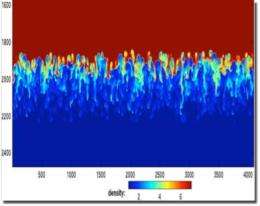Predictive simulation successes on Dawn supercomputer

(PhysOrg.com) -- The 500-teraFLOPS Advanced Simulation and Computing program's Sequoia Initial Delivery System (Dawn), an IBM machine of the same lineage as BlueGene/L, has immediately proved itself useful as several initial science results demonstrated ground-breaking science, enhanced code performance, and some of the highest resolution, largest simulations ever run in their respective scientific field.
Delivered to the Lawrence Livermore National Laboratory in January and February, Dawn (an IBM Blue Gene/P system) will lay the applications foundation for multi-petaFLOPS (floating point operations per second) computing on Sequoia, a 20-petaFLOPS IBM system to be delivered in late 2011.
All three ASC labs — Lawrence Livermore, Los Alamos, and Sandia — have been busy using Dawn for the past five months and have been generating exciting new results across a broad spectrum of applications.
“The rapidly increasing performance of new supercomputers, such as Dawn, allows us to perform calculations unimaginable only a few years ago,” said Denise Hinkel, AX Division's Plasma Theory Group Leader at LLNL. “Today's supercomputers are the enabling technology for predictive laser-plasma interaction modeling, and recent large-scale simulations on Dawn are helping guide focal-spot-size decisions for the National Ignition Facility beams and helping with ignition design optimization.”
Below are examples of NIF laser and other simulations recently run on Dawn.
-

Comparison of Dawn simulation (left) and physical experiment (right) of glass crack patterns. This simulation of dynamic brittle fracture is critical in the understanding of crack propagation using new peridynamics simulations. (Sandia) -

Evolution of electron temperature due to heating from a high-energy beam heating in a charged particle plasma-beam interaction simulation, providing insight about interactions that might occur in a fusion fast ignition experiment. (LLNL) -

Laser beam propagation simulation showing simulated backscatter inside an ignition target (left panel: laser light resonantly scatters off ion acoustic waves; right panel: laser light resonantly scatters off electron plasma waves). Such simulations help to optimize NIF target performance. (LLNL)
Provided by Lawrence Livermore National Laboratory


















